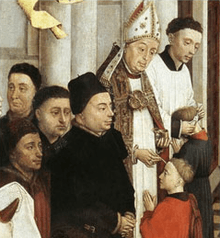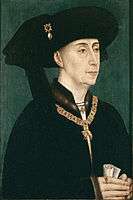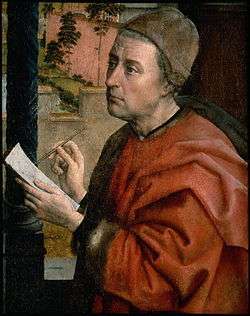Jean Wauquelin presenting his 'Chroniques de Hainaut' to Philip the Good

Jean Wauquelin presenting his 'Chroniques de Hainaut' to Philip the Good is a presentation miniature believed to have been painted by the Flemish artist Rogier van der Weyden (or if not actually from his hand then certainly by his workshop to his designs). It decorates the frontispiece to the Chroniques de Hainaut, a translation into French by Jean Wauqelin of the Latin history by Jacques de Guyse.
The translation had been commissioned by Philip, and the manuscript that both contains the miniature and shows it being presented was at that point the only one existing. From the court accounts the progress of the translation (though not the decoration of the manuscript) can be traced, and the miniature is presumed to date from around the time of the actual presentation to Philip in March 1448.[1] The entire set of three volumes are now in the Royal Library of Belgium.
It is the only known manuscript miniature by van der Weyden.[1]
Description
The decorative border includes the arms of the various territories making up Philip's dukedom, which he had considerably expanded, interspersed with his personal emblem of sparks being struck from a flint.
Although a miniature, its dimensions matches those of van der Weyden's smallest work on panel. The workmanship is of the very highest quality and precision. An example of the attention to detail are the several concentric contour lines added to the tail of the dozing dog, making it appear to wag.[2] It was copied in other presentation miniatures, some showing Charles the Bold at later ages.[1]
The attribution to van der Weyden is based not only on the mastery of execution, but also on the portrait evidence of some of the figures. Most of these can be identified, and amongst them Bishop Jean Chevrot (2nd from left), Chancellor Nicolas Rolin (3rd from left), Philip the Good (centre, 4th from left), and Charles the Bold (5th from left) appear in portraits by van der Weyden or his workshop, although in the case of Charles the Bold he appears as just an 11-year-old boy in the miniature (see Gallery below). The group on the right probably include Anthony, bastard of Burgundy and Antoine de Croy. Several of the group, including Philip, wear the collar of the Burgundian Order of the Golden Fleece.
The men's head-dress denotes their social position, with the highest ranked wearing variants of the chaperon, a garment then at the peak of its popularity. Philip the Good wears a black looped chaperon, Rolin a less exuberant version; only he has sufficient status to wear his chaperon indoors in the Duke's presence. Apart from the Bishop of Tournai, standing next to Rolin, all the other men are bare-headed, even Philip's young heir, despite the fact that several of them are high-ranking intimates who, like the Duke, wear the collar of the Order of the Golden Fleece. But as far as can be seen, all have hats. The man in grey seems to be carrying another sort of hat, but all the other ones visible are also chaperons, mostly with the cornettes to the front. The young Charles the Bold has his patte wrapped round the back of his neck, and the man on the extreme right has his bourrelet further than usual down his back, with the patte hanging down from it. Most of the chaperons are black, although the man in blue has one in salmon-pink; black was having one of its earliest periods of being the most fashionable colour at the time.[3]
Comparisons
One obvious comparison is the presentation miniature by Simon Marmion for Philip's copy of the Grandes Chroniques de France, in which Philip accepts it with many of the same figures present (including Nicolas Rolin and the future Charles the Bold) on January 1, 1457.[4] A book for Charles the Bold of 1468-70 includes a rather crude and simplified version of van der Weyden's scene.[5]
Gallery
 Detail from the Seven Sacraments Altarpiece showing Bishop Jean Chevrot administering Confirmation.[6]
Detail from the Seven Sacraments Altarpiece showing Bishop Jean Chevrot administering Confirmation.[6] Exterior of the Beaune Altarpiece commissioned by Chancellor Nicolas Rolin and portraying him and his wife as donors.[7]
Exterior of the Beaune Altarpiece commissioned by Chancellor Nicolas Rolin and portraying him and his wife as donors.[7] One of several copies of a now lost portrait of Philip the Good.[8]
One of several copies of a now lost portrait of Philip the Good.[8]
References
- 1 2 3 Gay and Kren, 91
- ↑ Watteeuw, pp. 180–3
- ↑ T Kren & S McKendrick (eds), Illuminating the Renaissance - The Triumph of Flemish Manuscript Painting in Europe, Getty Museum/Royal Academy of Arts, 2003, ISBN 1-903973-28-7
- ↑ Voronova and Sterligov, p. 120
- ↑ Kren & McKendrick, pp. 235-236
- ↑ Panofsky, p. 282
- ↑ Panofsky, p. 268
- 1 2 Panofsky, p. 294
- ↑ Campbell and van der Stock, p. 300
Bibliography
- Watteeuw, Lieve, A closer look at Rogier van der Weyden's Presentation Miniature (1447–1448) in Campbell, Lorne and Van der Stock, Jan. (ed.) Rogier van der Weyden: 1400–1464. Master of Passions. Leuven: Davidsfonds, 2009. ISBN 978-90-8526-105-6, pp. 370–418
- Panofsky, Irwin. Early Netherlandish Painting: v. 1. Westview Press, 1971 (new edition). ISBN 978-0064300025
- Gay, Richard, and Kren, Thomas, in: Kren, T. & McKendrick, Scot (eds), Illuminating the Renaissance – The Triumph of Flemish Manuscript Painting in Europe, Getty Museum/Royal Academy of Arts, 2003, ISBN 9781903973288 (exhibited, #3)
- Kren, T. & McKendrick, Scot (eds), Illuminating the Renaissance – The Triumph of Flemish Manuscript Painting in Europe, Getty Museum/Royal Academy of Arts, 2003, ISBN 9781903973288
- T. Voronova and A Sterligov, Western European Illuminated Manuscripts (in the St Petersburg Public Library), 2003, Sirocco, London
Further reading
- Lorne Campbell, "Rogier van der Weyden and Manuscript Illumination", Chapter 7 in Flemish Manuscript Painting in Context: Recent Research, Eds Elizabeth Morrison, Thomas Kren, 2007, Getty Publications, ISBN 0892368527, 9780892368525, Google books
External links
- "The Frontispiece to the Chroniques de Hainaut: An Introduction to Valois Burgundy". Art Department, State University of New York,. Archived from the original on 29 September 2013.
